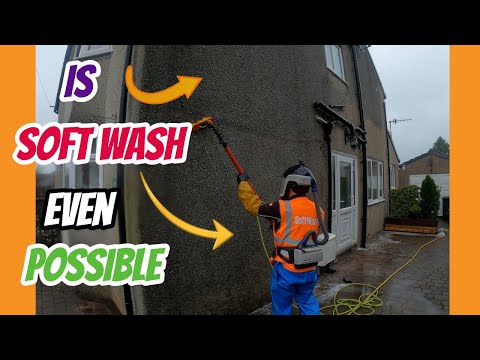
Another heavily stained pebbledash (drydash) property softwashed and steam cleaned.
One of the main advantages of a soft wash or as it’s known softwashing is that it is applied at low pressure, which ensures that even delicate surfaces aren’t damaged. This makes it the perfect cleaning method for those who want to maintain the look of their property without causing any harm to surface.
It’s different to Pressure Washing or Jetwashing in that it utilises low pressure to apply chemicals and rinse with hot water.
Softwashing kills the living spores of algae, mould, bacteria and organic biofilm that cold water pressure washing cannot remove.
Softwashing is a cleaning method used to remove dirt, grime, algae, and other organic growth from exterior surfaces of buildings and other structures. Unlike traditional power washing or pressure washing, softwashing uses a low-pressure water stream and specialised cleaning solutions to gently clean the surface without causing damage.
Softwashing typically involves applying a cleaning solution to the surface being cleaned, allowing it to dwell for a short period of time, and then rinsing it off with a low-pressure water stream. The cleaning solution is specifically designed to break down and remove organic growth, such as algae, moss, and lichen, without harming the surface being cleaned.
Softwashing is often used on surfaces such as roofs, siding, decks, fences, and sidewalks. It is a more gentle and effective cleaning method than traditional power washing or pressure washing, and can help to extend the life of exterior surfaces by removing harmful organic growth that can cause damage over time.
Soft washing house render
Removing algae from exterior facades
Render cleaningAlgae, mould, bacteria and organic biofilm is removed by Softwashing with a range of professional biocides and hot water.
Softwashing is a gentle and non-invasive cleaning method, making it ideal for use on
“dry dash” and “pebble dash” wall finishes.
The cleaning solutions used in softwashing typically include a mix of water, detergents, and other chemicals that are specifically formulated to break down and remove dirt, mould, mildew, bacteria that stain and discolour exterior a surfaces.
A biocide solution is applied to the surface being cleaned using a low-pressure spray, which is typically between 60 and 100 psi. The solution is allowed to sit for a period of time to allow it to penetrate and dissolve the contaminants on the surface.
After the biocide solution has had time to work, it is rinsed away using a low-pressure hot water. Softwashing is an effective method for cleaning and sanitizing surfaces without causing damage, as the low-pressure spray is gentle enough to avoid damaging delicate surfaces.
Dry dash render is a type of finish where small stone chips or pebbles are thrown or “dashed” onto the wet render surface. This creates a textured and decorative appearance. The process typically involves the following steps:
A base coat of render (usually cement-based) is applied to the exterior wall.
While the base coat is still wet, small stones or pebbles of a consistent size are thrown onto the surface. These stones adhere to the wet render and become embedded, creating a textured finish.
Once the render has dried and set, the excess loose stones are often brushed or washed away to reveal the textured pattern.
Dry dash render is valued for its durability, as it provides a protective layer that can withstand various weather conditions. It’s commonly used for both residential and commercial buildings.
Pebble Dash Render:
Pebble dash render is a specific type of dry dash render where the stone or pebbles used are larger and more prominently displayed on the surface. The process is similar to dry dash rendering but involves using larger pebbles or stones to create a more pronounced and distinct texture. The steps are essentially the same:
A base coat of render is applied to the wall.
Larger pebbles or stones are thrown onto the wet render, creating a more textured and rugged appearance.
After the render has dried and set, any excess loose stones are removed.
Both dry dash and pebble dash render provide not only aesthetic appeal but also protection to the underlying structure by shielding it from the elements. The choice between the two depends on the desired visual effect and the size of the stones or pebbles used.
Leave a Reply